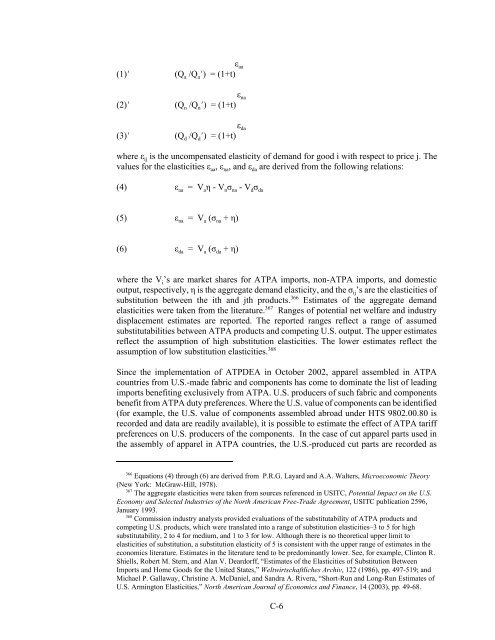The Impact of the Andean Trade Preference Act Twelfth ... - USITC
The Impact of the Andean Trade Preference Act Twelfth ... - USITC
The Impact of the Andean Trade Preference Act Twelfth ... - USITC
- No tags were found...
You also want an ePaper? Increase the reach of your titles
YUMPU automatically turns print PDFs into web optimized ePapers that Google loves.
(1)N(Q a /Q a N) = (1+t)ε aa(2)N(Q n /Q n N) = (1+t)ε na(3)N(Q d /Q d N) = (1+t)ε dawhere ε ij is <strong>the</strong> uncompensated elasticity <strong>of</strong> demand for good i with respect to price j. <strong>The</strong>values for <strong>the</strong> elasticities ε aa , ε na , and ε da are derived from <strong>the</strong> following relations:(4) ε aa = V a η - V n σ na - V d σ da(5) ε na = V a (σ na + η)(6) ε da = V a (σ da + η)where <strong>the</strong> V i ’s are market shares for ATPA imports, non-ATPA imports, and domesticoutput, respectively, η is <strong>the</strong> aggregate demand elasticity, and <strong>the</strong> σ ij ’s are <strong>the</strong> elasticities <strong>of</strong>substitution between <strong>the</strong> ith and jth products. 366 Estimates <strong>of</strong> <strong>the</strong> aggregate demandelasticities were taken from <strong>the</strong> literature. 367 Ranges <strong>of</strong> potential net welfare and industrydisplacement estimates are reported. <strong>The</strong> reported ranges reflect a range <strong>of</strong> assumedsubstitutabilities between ATPA products and competing U.S. output. <strong>The</strong> upper estimatesreflect <strong>the</strong> assumption <strong>of</strong> high substitution elasticities. <strong>The</strong> lower estimates reflect <strong>the</strong>assumption <strong>of</strong> low substitution elasticities. 368Since <strong>the</strong> implementation <strong>of</strong> ATPDEA in October 2002, apparel assembled in ATPAcountries from U.S.-made fabric and components has come to dominate <strong>the</strong> list <strong>of</strong> leadingimports benefiting exclusively from ATPA. U.S. producers <strong>of</strong> such fabric and componentsbenefit from ATPA duty preferences. Where <strong>the</strong> U.S. value <strong>of</strong> components can be identified(for example, <strong>the</strong> U.S. value <strong>of</strong> components assembled abroad under HTS 9802.00.80 isrecorded and data are readily available), it is possible to estimate <strong>the</strong> effect <strong>of</strong> ATPA tariffpreferences on U.S. producers <strong>of</strong> <strong>the</strong> components. In <strong>the</strong> case <strong>of</strong> cut apparel parts used in<strong>the</strong> assembly <strong>of</strong> apparel in ATPA countries, <strong>the</strong> U.S.-produced cut parts are recorded as366 Equations (4) through (6) are derived from P.R.G. Layard and A.A. Walters, Microeconomic <strong>The</strong>ory(New York: McGraw-Hill, 1978).367<strong>The</strong> aggregate elasticities were taken from sources referenced in <strong>USITC</strong>, Potential <strong>Impact</strong> on <strong>the</strong> U.S.Economy and Selected Industries <strong>of</strong> <strong>the</strong> North American Free-<strong>Trade</strong> Agreement, <strong>USITC</strong> publication 2596,January 1993.368 Commission industry analysts provided evaluations <strong>of</strong> <strong>the</strong> substitutability <strong>of</strong> ATPA products andcompeting U.S. products, which were translated into a range <strong>of</strong> substitution elasticities–3 to 5 for highsubstitutability, 2 to 4 for medium, and 1 to 3 for low. Although <strong>the</strong>re is no <strong>the</strong>oretical upper limit toelasticities <strong>of</strong> substitution, a substitution elasticity <strong>of</strong> 5 is consistent with <strong>the</strong> upper range <strong>of</strong> estimates in <strong>the</strong>economics literature. Estimates in <strong>the</strong> literature tend to be predominantly lower. See, for example, Clinton R.Shiells, Robert M. Stern, and Alan V. Deardorff, “Estimates <strong>of</strong> <strong>the</strong> Elasticities <strong>of</strong> Substitution BetweenImports and Home Goods for <strong>the</strong> United States,” Weltwirtschaftliches Archiv, 122 (1986), pp. 497-519; andMichael P. Gallaway, Christine A. McDaniel, and Sandra A. Rivera, “Short-Run and Long-Run Estimates <strong>of</strong>U.S. Armington Elasticities,” North American Journal <strong>of</strong> Economics and Finance, 14 (2003), pp. 49-68.C-6
















